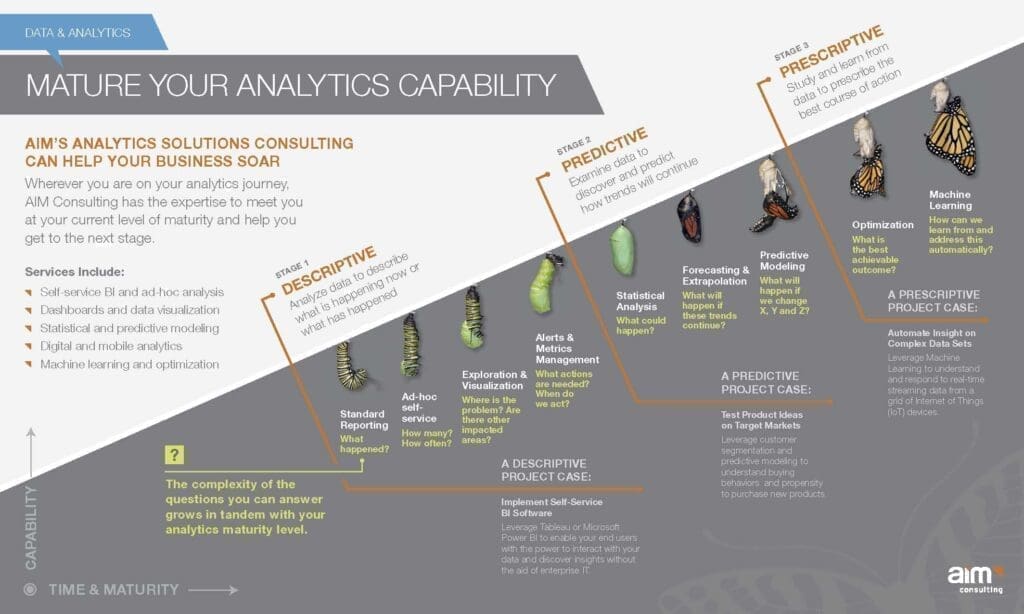
Analytics is of critical importance for an organization’s roadmap. Good analytics helps create the metrics which shape the roadmap of an organization and drive actionable results. Analytics also gives insights into history, competitive differentiation, and predictions about the future.
An organization’s analytics maturity can be described using an analytics maturity model. At AIM we employ a model with three levels of analytics maturity: Descriptive, Predictive, and Prescriptive.

Stage 1: Descriptive Analytics
Descriptive analytics, the simplest stage, groups data into useful bits of information in order to collect a summary or devise a conclusion. Descriptive analytics are used to understand the past and present and ask cut-and-dry questions such as “what happened?” and “how many?”
It is a stage where users, processes, and tools are more opportunistic or ad-hoc. Projects are focused on data visualization, reporting, and self-service BI.
Descriptive analytics includes services and answers questions like:
- Standard Reporting: What happened?
- Ad-hoc Self-service: How many? How often?
- Exploration & Visualization: Where is the problem? Are there other impacted areas?
- Alerts & Metrics Management: What actions are needed? When do we act?
Descriptive project case example: Implement self-service BI software
Leverage Tableau or Microsoft Power BI to enable your end users with the power to interact with your data and discover insights without the aid of enterprise IT.
Stage 2: Predictive Analytics
Predictive analytics is a higher stage, which examines data to discover and predict future trends. At this stage, projects are focused on predictive modeling, statistics, data mining, and advanced analysis. Predictive analytics is used to answer future-focused questions like “what would happen if we change X?”
Predictive analytics includes services and answers questions like:
- Statistical Analysis: What could happen?
- Forecasting & Extrapolation: What will happen if these trends continue?
- Predictive Modeling: What will happen if we change X, Y and Z?
Predictive project case example: Test product ideas on target markets
Leverage customer segmentation and predictive modeling to understand buying behaviors and propensity to purchase new products.
Stage 3: Prescriptive Analytics
Prescriptive analytics is the highest and most transformative stage, where an organization has the tools to learn from data how to prescribe the best course of action as well as predict possible future outcomes.
One example is machine learning, which focuses on algorithms that can learn and grow when exposed to new data. With prescriptive analytics, you can answer questions like “how can we learn from and address this automatically?”
Prescriptive analytics includes services and answers questions like:
- Optimization: What is the best achievable outcome?
- Machine learning: How can we learn from and address this automatically?
Prescriptive project case example: Automate insight on complex data sets
Leverage machine learning to understand and respond to real-time streaming data from a grid of Internet of Things (IoT) devices.
Mature Your Analytics Capability
From planning a multi-year analytics strategy and roadmap to creating an analytics center of excellence to launching a proof-of-concept in any of the types of analytics (descriptive, predictive, or prescriptive), AIM Consulting has the expertise to meet organizations at their current level of maturity and help you get to the next stage.
Need Help Turning Insights Into Action?
We leverage proven analytics methodologies, best practices and tools to define the right analytics solutions for you, solving complex business challenges and driving future growth.




